Seahorses look and act quite unlike most other fish - for a start, swimming is not their forte.
Discover the peculiar features, abilities and behaviours that make seahorses and their closest relatives such an intriguing group.
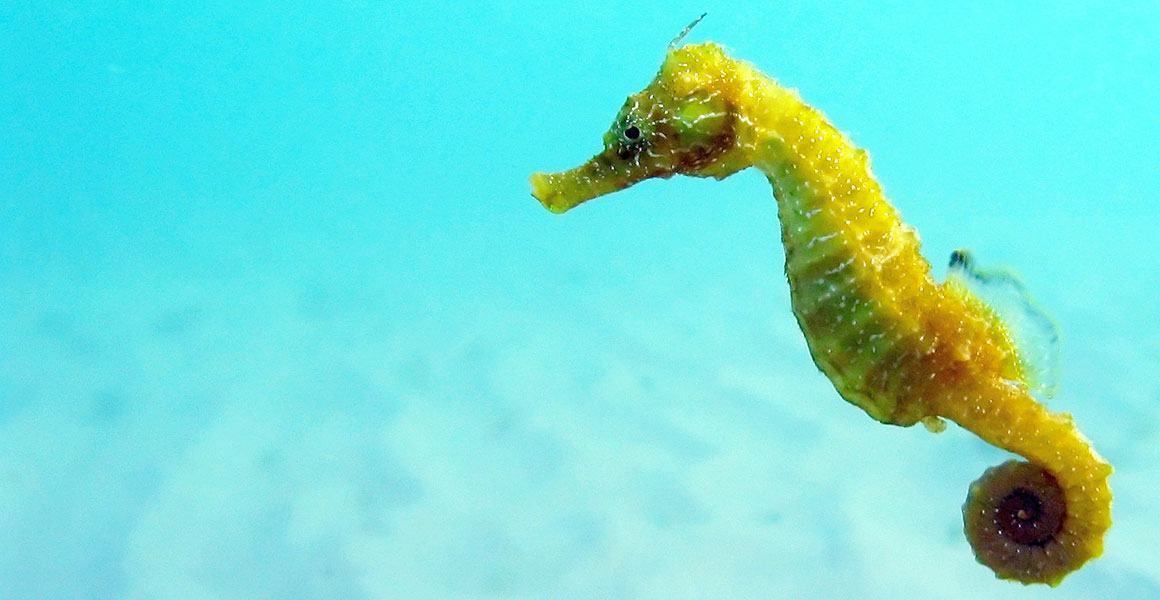
Seahorses are a unique genus of fish with a peculiar collection of features © Florin DUMITRESCU/ Wikimedia Commons (CC BY-SA 3.0)
Seahorses look and act quite unlike most other fish - for a start, swimming is not their forte.
Discover the peculiar features, abilities and behaviours that make seahorses and their closest relatives such an intriguing group.
There are at least 40 species of seahorses known to science, living in both temperate and tropical waters around the world. Seahorse species belong to the genus called Hippocampus, also the name of a part of vertebrates' brains. The anatomical hippocampus was allegedly named for its resemblance to the shape of a seahorse.
Seahorse species vary vastly in appearance and size. The largest reach up to 35 centimetres in length, whereas the smallest can be just two centimetres when fully grown.
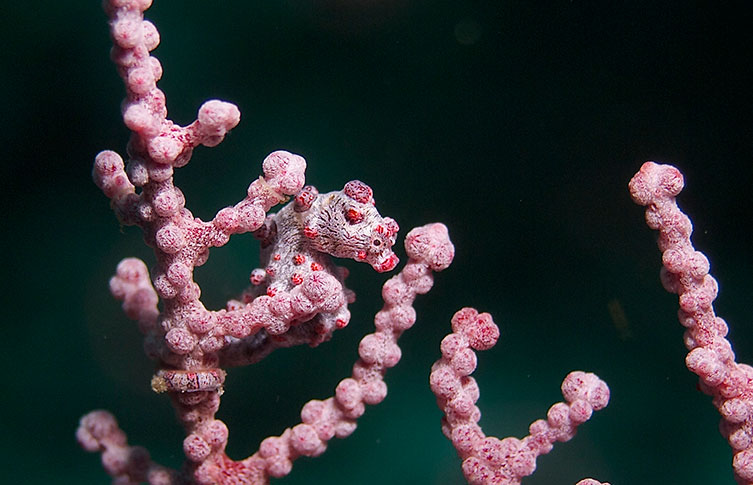
Described and named in 1970, Hippocampus bargibanti (pictured) was the first pygmy seahorse species known to science. This species uses camouflage, only living on sea fan coral in a colour they can blend in with. © Elias Levy/ Flickr (CC BY 2.0)
Male seahorses bear the responsibility of carrying the embryos. They have a brood pouch on the front of their bodies, and fertilised eggs are transferred there with an ovipositor. The male then carries these eggs for nine to 45 days, depending on the species.
The eggs hatch inside the pouch and the young (known as fry) are released as miniature, fully-formed seahorses. Some species release over 1,000 tiny offspring into the surrounding water. This paternal behaviour is also seen in some pipefishes, which are close relatives of seahorses.
Seahorses have a lifespan of between one and five years, although fry have a less than 1% survival rate. As soon as seahorses are born, they become independent of their parents and are at high risk of being picked off by predators such as crustaceans and larger fish.
These upright fish have a dorsal fin that flutters 30 to 70 times per second to provide forward propulsion. They also have a set of small pectoral fins near the back of their head that are used to steer. But seahorses are not strong swimmers.
Instead of tail (caudal) fins, seahorses have long prehensile tails to anchor themselves by grabbing onto objects such as seagrass, seaweed and coral. They are also masters of camouflage, specially adapted to blend seamlessly with their surroundings, often by changing their colour. This helps them to hide from predators such as other fishes and crustaceans, and allows them to ambush prey.
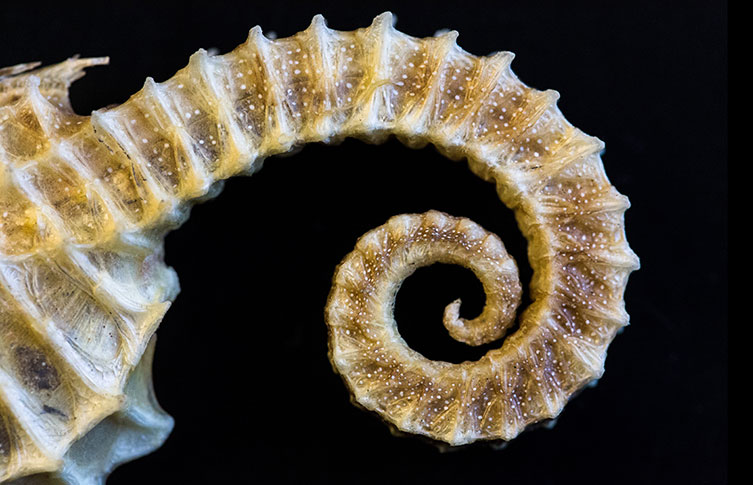
Seahorses' segmented tails have a square (rather than circular) cross-section © Chris Smith/ Flickr (CC BY-NC-SA 2.0)
Animal tails are usually round, but seahorses' are square-shaped. A 2015 study showed that this could enhance the fish's grip by increasing the surface area of the tail in contact with an object.
Seahorses are encased in bony, segmented armour that can compress without causing damage to the animal, helping to protect them from predators. These armoured plates and the three types of joint in their tails also limit the potential damage caused by excessive twisting when gripping onto plants or coral.
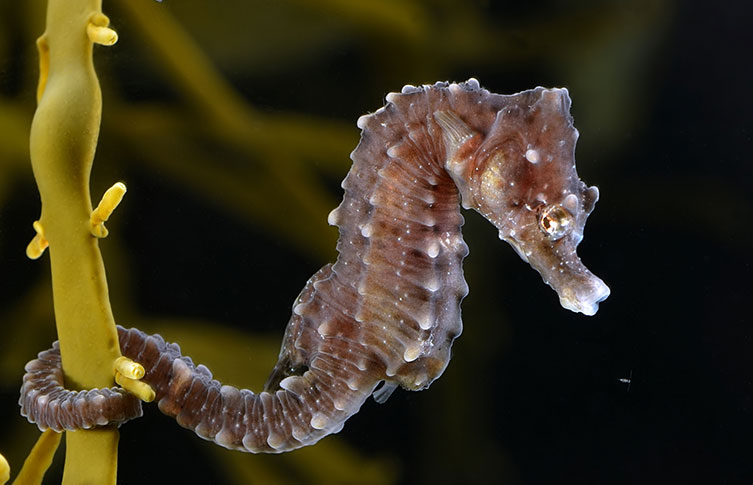
The short-snouted seahorse (Hippocampus hippocampus) is one of the species that can be found in UK waters. They are protected by the Wildlife and Countryside Act 1981. © Hans Hilewaert / Wikimedia Commons (CC BY-SA 4.0)
Seahorses are carnivorous and have a voracious appetite. Food passes extremely quickly through a seahorse's digestive system so adults constantly graze to stay alive.
As they are weak swimmers, seahorses ambush their prey rather than pursuing it. They use their long snouts to suddenly and rapidly slurp in water and food, swallowing their catch whole. They will eat any live animal that is small enough to fit through their toothless jaws which are fused open. Their main food source is tiny crustaceans such as shrimp and copepods.
The hunt for dinner is made easier by each eye being able to move independently. The animal's bent neck can also stretch out to grab passing food.
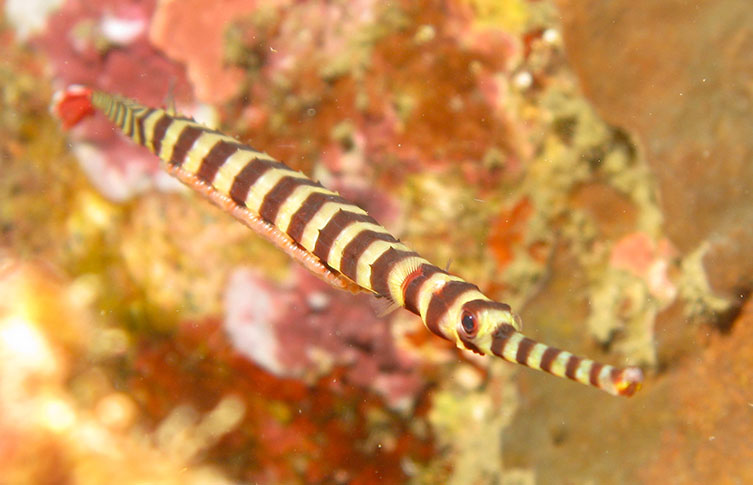
Seahorses are members of the family Syngnathidae, a group that also comprises pipefishes and seadragons. These animals can be found all around the world, mainly near coasts.
All have some similarities in their appearances, such as their elongated and fused snouts and rigid bodies. Male seadragons and pipefishes, like seahorses, carry the female's eggs. But instead of a pouch like seahorses, seadragons carry the eggs directly on the underside of their tails - in pipefishes it depends on the species.
Fossils of extinct seahorse species dating back to the Middle Miocene (approximately 13 million years ago) have been found in the Tunjice Hills in Slovenia. These animals are similar to living species of seahorse.
Seahorses are thought to have evolved their upright posture in response to an increase in shallow water habitats, especially seagrass, that occurred during the Oligocene (33.9 to 23 million years ago). The pipefish, seadragon and seahorse family, Syngnathidae, evolved during the Eocene (at least 50 million years ago), around the same time that great white shark ancestors started to appear.
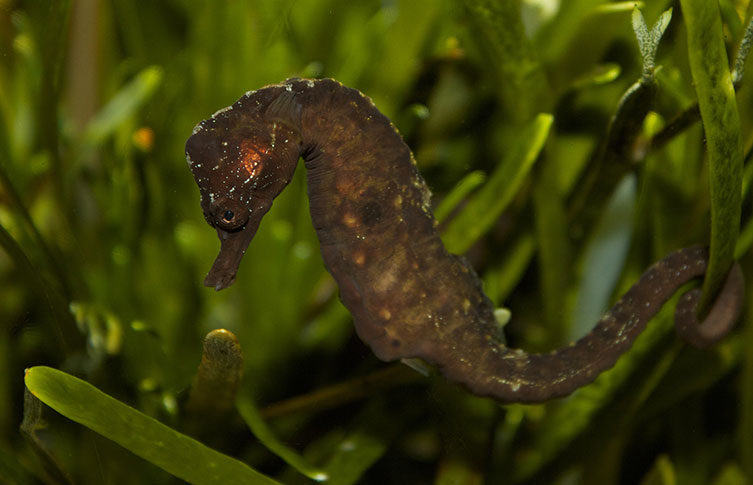
A Knysna seahorse (Hippocampus capensis) with its prehensile tail grasped around a piece of seagrass. This species is primarily found in vegetated areas around the coast of South Africa. They are at very high risk of extinction. © Brian Gratwicke/ Flickr (CC BY 2.0)
Only two species of seahorse are native to UK waters: the long-snouted seahorse (Hippocampus guttulatus) and the short-snouted seahorse (Hippocampus hippocampus). These species are protected under the UK's Wildlife and Countryside Act 1981.
Both are found along most of the UK coastline, with some large populations observed occasionally. But like other small fish, seahorse populations naturally increase and decrease. They have a patchy distribution, meaning they don't occur uniformly across a favoured habitat.
The International Union for Conservation of Nature (IUCN) currently list several seahorse species around the world as vulnerable to extinction.
Throughout the oceans, pollution and other human activities are damaging habitats that the seahorses rely on. Loss of seagrass and coral reefs, along with overuse in traditional medicine and bycatch by the fishing industry, are thought to be a key cause of decline in seahorse populations.
The situation is so bad that some species, including White's seahorse (Hippocampus whitei) and the Knysna or Cape seahorse (Hippocampus capensis), are now considered endangered. This means that some of these these unique fish are now at very high risk of extinction.
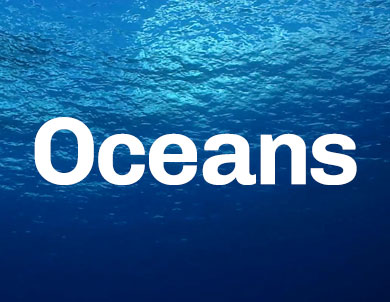
Find out more about life underwater and read about the pioneering work of the Museum's marine scientists.

Find out about the plants and animals that make the UK home.
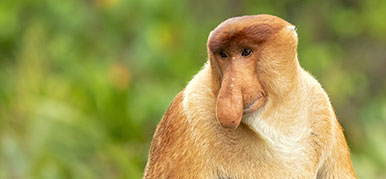
Just how weird can the natural world be?

Learn from top experts with our on-demand, online courses, designed for all levels of interest in the natural world.
Don't miss a thing
Receive email updates about our news, science, exhibitions, events, products, services and fundraising activities. We may occasionally include third-party content from our corporate partners and other museums. We will not share your personal details with these third parties. You must be over the age of 13. Privacy notice.
Follow us on social media